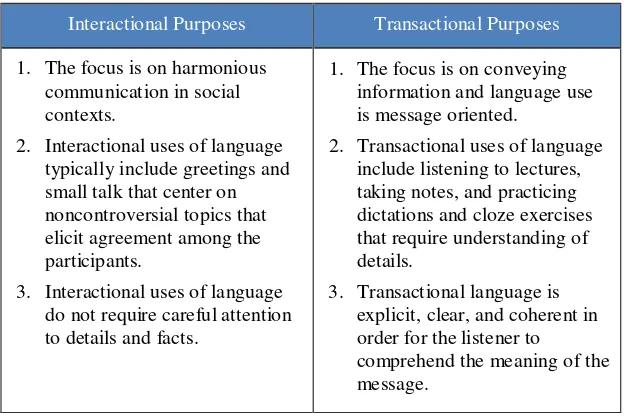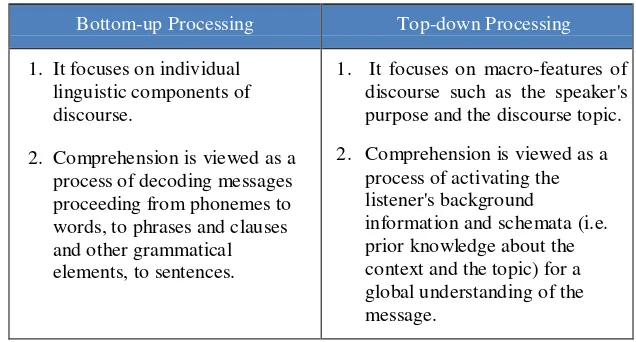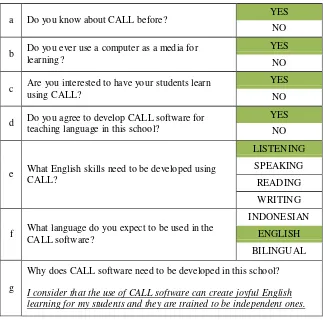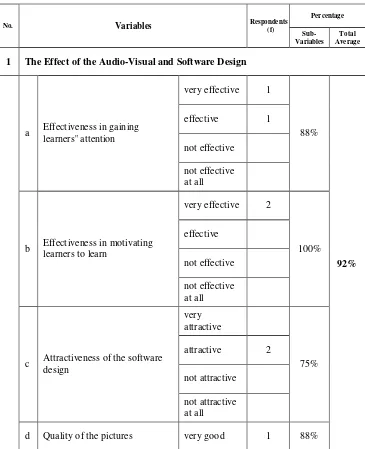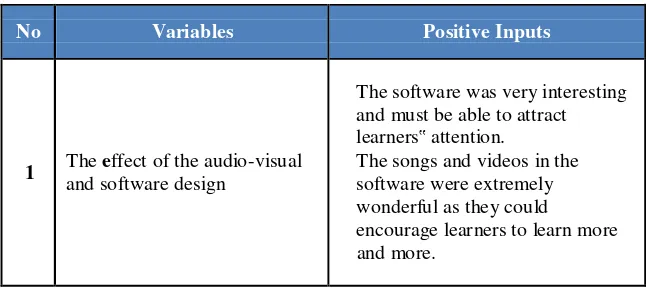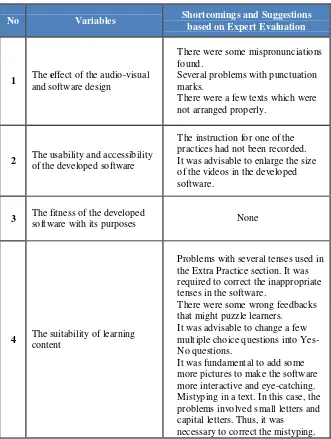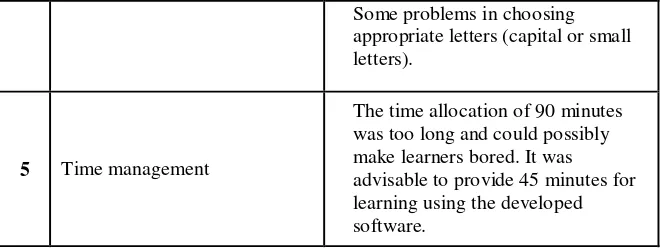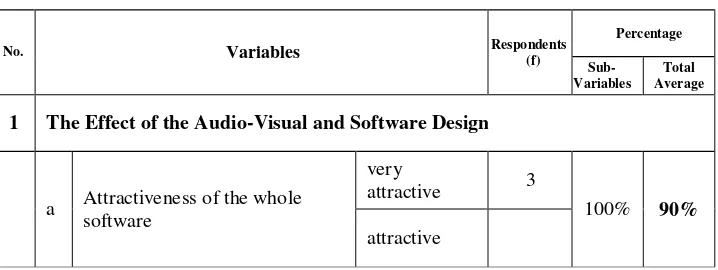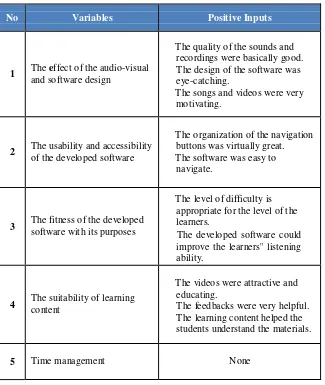IMPROVING THE LISTENING SKILL OF
THIRD-GRADE STUDENTS OF DHARMA MULYA
CHRISTIAN SENIOR HIGH SCHOOL SURABAYA
A THESIS
In Partial Fulfillment of the Requirements for the Sarjana Pendidikan Degree in the English Language Teaching
By: Peedo
Salim
1213006060
ENGLISH DEPARTMENT
FACULTY OF TEACHER TRAINING AND EDUCATION
WIDYA MANDALA CATHOLIC UNIVERSITY SURABAYA
(1)
This thesis entitled Developing Listening Software for Improving the Listening Skill of Third-Grade Students of Dharma Mulya Christian Senior
High School Surabaya, prepared and submitted by Peedo Salim (1213006060) has been approved and accepted as a partial fulfillment of the requirements for the Sarjana Pendidikan Degree in the English Language Teaching by the following advisor:
Advisor
(2)
This thesis has been written and submitted by Peedo Salim
(1213006060) for acquiring the Sarjana Pendidikan Degree in English Language Teaching by the following Broad of Examiners on oral exam with
the grade of on July 9th,2010.
Secretary
Dayy Budiono. M.Hum. Member
PUBLIKASI KARYA ILMIAH
Demi perkembangan ilmu pengetahuan, saya sebagai mahasiswa Unika
Widya Mandala Surabaya:
Nama : Peedo Salim
: 1213006060
Menyetujui skripsi/karya ilmiah saya :
Judul
Developing Listening Software for Improving the Listening Skill of Third-
Grade Students ofDharma Mulya Christian Senior High School Surabaya.
Untuk dipublikasikan/ditampilkan di internet atau media lain (Digital
Library Perpustakaan Unika Widya Mandala Surabaya) untuk kepentingan
akademik sebatas sesuai dengan Undang-Undang Hak Cipta.
Demikian pernyataan persetujuan publikasi karya ilmiah ini saya buat
dengan sebenarnya.
Above all, the writer would like to the almighty God for His
presence, His guidance, His blessings, His love, and His mercy that enable
him to accomplish this thesis in due time.
The writer feels sincerely indebted to those who have given their
guidance, encouragement, valuable hours, love, and support that finally
bring him towards the completion of his thesis especially to:
1. Y.G. Harto Pramono, Ph.D., the writer's thesis advisor, for his trust,
understanding, tolerance and kindness in advising or guiding the
writer from the beginning until the finishing touch with full of
patience and never-ending support. He has also given his brilliant
ideas, valuable comments and suggestions.
2. P. Hady Sutris Winarlim, M. Sc., the Head of the Department, for his
support and wisdom during the completion of the study.
3. Drs. Nus Marlessy, the Headmaster of Dharma Mulya Christian
Senior High School Surabaya, who has given a chance to conduct
several try-outs in the school.
4. All teachers of Dharma Mulya Christian Senior High School
Surabaya, especially Dra. Megawati Suyono, the Vice Headmaster,
who has provided the information needed for accomplishment of this
thesis.
5. All the third-grade students of Dharma Mulya Christian Senior High
School Surabaya who have seriously served as the respondents for
the questionnaire while conducting the try-outs of the product.
6. The writer’s beloved parents, Kiwajono Salim and Ong Ling-Ling,
for their support both mentally and financially and their continuous
prayers to the Lord for my success.
Mandala Catholic University who have helped the writer from t he
first semester until he has eventually finished his thesis.
8. Ronny Salim, S. Pd., the writer’s eldest brother, who has willingly
supported the development of the product by recording his voices.
He has spent abundant hours for helping the writer to accomplish the
study.
9. The writer’s colleagues, Angel and Gemma Holliani Cahya, for
continuously supporting the writer in completing the thesis. They
were also willing to spend their precious time for recording their
voices.
10. The writer’s colleagues, Angel, Gemma Holliani Cahya, Edwin
Tanujaya, and others whom the writer could not mention one by one
since this space is limited, for continuously supporting the writer in
completing this thesis.
May Lord Jesus Christ bless all of them.
The writer does realize that this thesis is still far from perfection.
Accordingly, comments and suggestions concerning the improvement of
this thesis are appreciatively welcome. Eventually, the writer does expect
that this thesis and the developed learning software are helpful for those
who use and really need it.
TITLE ... i
APPROVAL SHEET (1) ... ii
APPROVAL SHEET (2) ... iii
ACKNOWLEDGEMENTS ... iv
TABLE OF CONTENTS ... vi
LIST OF PICTURES ... ix
LIST OF TABLES... x
LIST OF DIAGRAMS ... xi
LIST OF APPENDICES ... xii
ABSTRACT ... xiii
CHAPTER I: INTRODUCTION ... 1
1.1 Background of the Development... 1
1.2 Statement of the Problems ... 7
1.3 Objectives of the Study... 8
1.3.1 General Objective ... 8
1.3.2 Specific Objectives... 8
1.4 Expected Product Specifications ... 8
1.5 Significance of the Development ... 11
1.6 Assumptions and Limitations of the Development ... 12
1.7 Definition of Key Terms ... 13
1.8 Organization of the Thesis ... 14
CHAPTER II: REVIEW OF RELATED LITERATURE ... 16
2.1 Theories of Listening ... 16
2.1.1 The Importance of Listening ... 16
2.1.2 Nature of Listening ... 16
2.1.3 Listening Purposes ... 19
2.1.4 Listening Processes ... 19
2.1.7 The Principles of Teaching Listening Comprehension ... 31
2.1.8 The Processes of Teaching Listening ... 32
2.2 Theories of Learning ... 34
2.2.1 Teacher vs. Learner-centered Instructions ... 34
2.2.2 Learning Styles ... 34
2.3 Computer-assisted Language Learning (CALL) ... 37
2.3.1 Nature of Computer-assisted Language Learning ... 37
2.3.2 Types of Computer-assisted Language Learning ... 38
2.3.3 Types of CALL Content ... 39
2.3.4 Three Phases of CALL ... 40
2.3.5 Forms of CALL Software... 42
2.3.6 Designs of CALL ... 43
2.3.7 Characteristics of Effective CALL Software... 44
2.3.8 Advantages of CALL ... 46
CHAPTER III: PROCEDURES OF THE DEVELOPMENT ... 49
3.1 Procedures of Product Prototype Development ... 49
3.1.1 First Step: Deciding the Material to be Developed through Needs Analysis... 52
3.1.2 Step: Identifying the Standard of Graduate Competency of the Material to be Developed ... 52
3.1.3 Third Step: Developing the CALL Software... 53
3.1.4 Fourth Step: Producing CALL Software ... 56
3.1.5 Fifth Step: Conducting Evaluation by Experts and Product Try- outs ... 60
3.2 Product Try-Outs ... 60
3.2.1 Design of Product Evaluation and Try-outs ... 60
3.2.2 Subjects of the Product Evaluation and Try-outs ... 62
3.2.3 Types of Data ... 62
3.2.4 Instruments and Techniques of Data Collection ... 63
3.2.5 Techniques of Data Analysis ... 64
3.3 Previous Studies on the Use of CALL... 67
CHAPTER IV: REPORTS ON THE RESULT OF THE DEVELOPMENT ... 69
4.1 Result of Needs Analysis ... 69
4.1.1 The Data of the Needs Analysis... 70
4.2 Report on the Process and Result of the Development ... 74
4.2.1 Pre-evaluation by the Subject Specialist and Instructional Technologist... 75
4.2.1.1 Revision of the Product (1st Revision) ... 90
4.2.2 Individual Try-out ... 94
4.2.2.1 Revision of the Product (2nd Revision)... 111
4.2.3 Field Try-out ... 113
4.2.3.1 Revision of the Product (3rd Revision) ... 134
4.3 Summary of the Process of the Product Development and Conclusion of the Result of the Product Development ... 136
4.3.1 Summary of the Process of the Product Development ... 136
4.3.2 Conclusion of Product Development Result ... 137
CHAPTER V: DISCUSSION AND SUGGESTIONS ... 139
5.1 Discussion of the Revised Product ... 139
5.2 Suggestions ... 144
BIBLIOGRAPHY ... 148
APPENDICES
Picture 3.1. Attention Gaining-materials ... 56
Picture 3.2. The Instructional Objectives ... 57
Picture 3.3. Content of the Software ... 57
Picture 3.4. Multiple-choice Exercises ... 58
Picture 3.5. Listening-to-songs Exercises... 58
Picture 3.6. An Example of Test ... 59
Picture 3.7. An Example of Test ... 59
Picture 3.8. Feedback for Correct Answers ... 59
Picture 3.9. Feedback for Wrong Answers ... 59
Table 2.1 The Differences between Interactional and
Transactional Purposes ... 19
Table 2.2 The Principles of Bottom-up and Top-down Processes ... 20
Table 4.1 Data Analysis of Needs Assessment ... 71
Table 4.2 The Result of Pre-evaluation ... 76
Table 4.3 The Positive Inputs from the Subject Specialist and the Instructional Technologist... 87
Table 4.4 The Shortcomings and Suggestions from the Subject Specialist and the Instructional Technologist ... 89
Table 4.5 The Problems to Revise and the First Revision ... 90
Table 4.6 The Result of Individual Try-out ... 94
Table 4.7 The Positive Inputs from the Three Respondents of Individual Try-out ... 109
Table 4.8 The Shortcomings and Suggestions from the Three Respondents of Individual Try-out ... 110
Table 4.9 The Problems to Revise and the Second Revision ... 111
Table 4.10 The Result of Field Try-out ... 113
Table 4.11 The Positive Inputs from the Sixty Respondents of Field Try-out ... 132
Table 4.12 The Shortcomings and Suggestions from the Sixty Respondents of Field Try-out ... 133
Table 4.13 The Problems to Revise and the Third Revision... 134
Table 4.14 Data of Process and Results of the Product Development .... 136
Diagram 3.1. Procedures of Product Development ... 50
Diagram 3.2. Design of Product Evaluation and Try-outs... 60
1. Needs Analysis Questionnaire ... 1
2. Questionnaire of Pre-evaluation by Subject Specialist and
Instructional Technologist ... 2
3. Questionnaire of Individual and Field Try-outs by Three Learners
and Sixty Learners ... 6
4. Standard of Graduate Competency ... 12
Peedo Salim, 2010, Developing Listening Software for Improving the Listening Skill of Third-Grade Students of Dharma Mulya Christian Senior High School Surabaya. Bachelor Thesis, English Department of Teacher Training and Education, Widya Mandala Surabaya Catholic University.
Advisor : YG. Harto Pramono, Ph.D.
Keywords : Computer-Assisted Language Learning, Self Learning, Listening Comprehension.
It has been broadly accepted that English is considered as an international language. Accordingly, English is taught as the first foreign language from kindergarten up to high schools. In order to be successful learners of English as a foreign language, we need the mastery of the four language skills, namely: listening, speaking, reading, and writing. Among those skills, listening is the most essential one in communication since people principally hear first before producing sounds.
Learning listening, however, should be supported by adequate learning resources if a successful teaching-learning process is to occur. The reality shows that the limited learning resources have caused the learning of listening skill to be problematic for students. In some senior high schools, the main resources used in learning English are mostly English textbooks. On the other hand, many of textbooks are designed and developed without considering the needs of the school. It, by all means, makes it difficult for some students to comprehend the materials. That problem happened to the students of Dharma Mulya Christian Senior High School Surabaya. Concerning the fact, an improvement of the way in learning listening is prominently needed. Thus, producing and developing an alternative learning resource to learn listening by utilizing computer technology is believed to be able to make the learning more effective and attractive. Computer- Assisted Language Learning is one of the alternative resources to solve the learning problem.
The main objective of this study is to produce CALL software for improving listening skill of the third-grade students of Senior High Schools. The components and design of the software are made in a way that could motivate students to learn listening more effectively and attractively. The
There were five steps that had been followed in the process of developing this learning software as the product of this developmental study, namely: (1) deciding the material which was going to be developed via needs analysis, (2) identifying the syllabus of the material going to be developed (based on standard of graduate competency), (3) developing the software, (4) producing the software, and (5) conducting product try-outs.
In order to produce good quality software, an evaluation was conducted by experts and it was then used as the basis for the first revision. Furthermore, a series of try-outs by students were done and the results of the try-out were used as the basis for revision in order to improve the quality of the software: (l) individual try-out with three students and the result was used as the basis for the second revision, (2) field try-out with sixty students and the result was used as the basis for the third revision. The subjects were third-grade students of Dharma Mulya Christian Senior High School Surabaya. The data of the try-outs were in the form of percentage and can be used as an alternative media for learning listening. In additio n, it can be used to improve the students’ listening skill and to increase their motivation in learning English, to introduce the model of electronic learning using computer, and the materials are appropriate for third-grade students of Senior High School.
CHAPTER I
INTRODUCTION
1.1 Background of the Development
In several developing countries, English is regarded as a second
language or foreign language. It is the principal language preferred for
international business and communication between countries all over the
world. Not only is English used for those fields, but it is also used in all
areas of human activities from science, entertainment, politics, education
and many others.
The role of English in Indonesia has become extremely significant
nowadays due to the rapid world development that demands the people
connect with other countries. The Indonesia’s Minister of Education in his
statement as quoted by Pramono (1996) states that English is intended to
provide students an opportunity to gain science and at the same time
develop their language of English in anticipation of the environmental
condition which has been influenced by the development of science,
technology, arts, and cultures such that the knowledge of English is a
demand. Many schools today have consequently started to teach English
from kindergarten up to high schools. They are anxious to support
Indonesian generation from children to adults.
Computer as one of the implementation of technology development
is able to support English teachers in dealing with teaching learning process
and promoting the learning outcome. Recently most language institutions
and schools in Indonesia make use of computers for supporting language
teaching and learning process. A number of educators and trainers can
generate interactive learning media as an alternative and complimentary
way to be utilized in English language learning. They accept as true that
using computers can diminish the students’ boredom in becoming skilled at
languages. Numerous researches, studies, and class experiments in the use
of information technology in language learning, in fact, show that
technology carries more advantages and development than disadvantages.
In the study of foreign language, nothing is more difficult than
learning to attain information by listening to native speakers. The students
learning listening often fail to recognize words and phrases which they
could understand if they saw them in print and unfamiliar rhythms of
sentences further complicate their task (Allen. 1980:1). In line with that
statement, it is essentially more difficult to differentiate a new word by
listening than by reading the passage. Listening is the central to language
learning. Listening skill serves as the basis for the development of speaking,
reading, and writing since children's first language is listening. Before they
learn to speak, they acquire their native speech from the sound heard in their
home and afterward they reproduce what one says. Therefore, listening is
considered as a fundamental and important skill in language learning
(Zaytoun. loc cit).
McKeating says, as quoted by Nicholas (1988: 19), that there are 3
reasons why we may possibly feel obligated to teach listening:
1. The fact that listening comprehension is one of the items on some
language examinations.
2. Listening is mostly used in all the communicative activities and
many enjoyable activities such as listening to the radio, to music and
watching television or films.
3. Listening is a medium of instruction in other school subjects.
Consequently, the students need to be good listeners in their
The skill of listening with comprehension is an essential part of
communication and the basic to foreign language learning. As a matter of
fact, one needs to improve his listening skill in order to be able to
communicate well with other people. Byrne (1976:9) states that listening is
really important in communication since people principally communicate in
a two-way process between speaker and listener.
People might have no success when they do not have a good
listening ability in the language they use to express themselves. Since
listening is a skill to understand one’s thoughts or ideas, people would not
be able to think sufficiently in the language concerned if they do not have
adequate listening ability. They can more easily understand and be
understood by others if they have good listening skill. Burt cites "In fact, it
is difficult to understand thoughts or ideas going on without listening to
effectively” (Burt. 1971 .105).
Senior High School students, particularly, really need a good
mastery of listening especially those continuing their study at an English
Department or abroad. By mastering the listening skill, the students will be
able to remember some of the detailed information they have heard in order
to answer questions correctly. In addition, listening is exactly useful for the
students to widen their knowledge of vocabulary in order to cope with
unfamiliar words heard when they listen to spoken English (Sutjipto,
1983:35). It shows that listening can help the students enrich their bank of
vocabularies. The students will find new words and some new expressions
by practicing listening.
Reacting the importance of listening skill, the increasing use of
English in many parts of the world, and the worldwide development of
technology, the researcher, representing English Department of Teacher
University, has a point of objective to produce learning software to t each
listening to the third-grade students of Dharma Mulya Christian Senior
High School Surabaya since the students have often encountered boredom
in learning listening which gives impact on the students’ motivation to learn
more, there has been no variation in learning resources of listening exercises
provided (still narrow on textbooks), and the listening exercises available in
Dharma Mulya Christian Senior High School Surabaya do not practically
emerge in operating videos/audios. In addition, there are no available
English learning software and learning resources that are developed for
being attractive, motivating learners, being an easy-learning source, and
individualized in that school. This was confirmed while consulting the
problems with the English teacher of Dharma Mulya Christian Senior High
School Surabaya.
In regard of the teaching learning process which relies on books
often causes students’ lack of interest, the development of the learning
software is aimed to improve the conventional methods in language learning
which mainly depend on textbooks that requires the presence of teachers in
the classroom to convey the material. Moreover, it is found that books are
not various and the feedback given is totally limited or even not available at
all.
As stated by Pramono (1996), unlike books, electronic learning
material that is effectively designed will facilitate the achievement of
desired learning outcomes. Furthermore, learning by using computer will
enable learners to choose the preferred topic, according to their level of
ability and will advance learners’ motivation in learning.
There have already been quite many learning software available in
attractively provided with adequate feedback. Feedback in learning software
seems to be the most significant aspect because without feedback a learner
is left to perform with no sense of direction or measure of correctness
(Cates, 1988). Carelessly designed software can possibly block the
effectiveness of learning.
As cited above that the use of computer learning software can be one
of the ways to solve the difficulties of learning English language,
developing effectively-designed software is recommended.
Language acquisition comprises two types, i.e., receptive skills and
productive skills. Receptive skills are those as what we have called them
Reading and Listening, while the productive skills cover Writing and
Speaking. However, to start producing something, in this case writing and
speaking, language learners must receive input by reading and listening, in
which they will start to gain new knowledge to be used to produce some
words, phrases or a sentence. Therefore, by starting to put attention on the
teaching of listening more critically, the development of language learners’
acquisition in English will improve gradually.
Teaching listening nowadays, however, meets many hurdles that
give impact on the students’ achievement in English language classrooms.
This, of course, is caused by numbers of factors. One of those factors is the
teaching and the learning process itself. Since the process is a systematic
process, every component is influencing one another to the students’
achievement. The fact of the teaching English, for example in Dharma
Mulya Christian Senior High School Surabaya, shows that students are less
interested in the materials given and to how those materials are presented to
them. Though materials are varied, the source is still narrowed on
textbooks. The students’ motivation to learn listening is evidently falling.
decline. Moreover, in some extent the students seem to neglect instructions
in English test, as they are less interested in listening. This fact is then
identified as the flaws of the material or the learning sources, in which they
are less interested and less motivating. Yet, the essence of learning is that
the students learn, which means students have to interact with sources of
learning which are used to gain the objective. In this case, alternatives to
cope the problems should be taken.
As a controlling though, there is a finding that every class has
students with different competences. Thus, there should be a technique to
facilitate the teaching to be effective above all diversity in the students’
aptitude as also in line with it. To fulfill this need, that a plan of learning
should pay attention to individuals, an interactive source as so-called CALL
(Computer-assisted Language Learning), is developed to give the learning
material an entertaining and enjoyable touch.
The Computer-assisted Language Learning serves the edutainment
and gives more credit in individual learning, which increases the motivation
of the learners to learn more. In this way, learners then have the freedom to
learn according to their own needs and capacity of interests.
It is accepted as true that media can be utilized as functional tools to
aid the English teachers and the foreign language learners during the
teaching and learning activities. On account of the problems stated above, it
is noteworthy to design CALL media (as a functional tool) properly to help
learners have a better understanding towards the lesson more easily.
Interactivity as one of computer-based learning multimedia modes"
is a necessary and fundamental mechanism for knowledge acquisition and
the development of both cognitive and physical skills" (Baker, 1994:1).
Interaction by means of computers as the media will be developed in this
multimedia includes audio (speech, sounds, music), video (text, graphics,
pictures, animations, movies) and interactivity (via keyboard, mouse,
microphone). The ability to interact with multimedia allows language
learners to explore, discover, ponder, search, question, answer and receive
feedback.
Taking into account the importance of listening skill as one of the
English skills that is tested for Ujian Nasional (UNAS) and the roles of
computers in teaching and learning processes, the development in this study
is to provide interesting and motivating learning software to help improve
the listening skill of the students of Dharma Mulya Christian Senior High
Schools Surabaya.
1.2 Statement of the Problems
In line with the description presented on the background of the study,
the CALL software development for teaching listening finds various
problems which appear as follows:
1. The students of Dharma Mulya Christian Senior High School
Surabaya encounter boredom in learning Listening which gives
impact on their motivation to learn more.
2. There is no variation in learning resources of listening exercises
given. In this case, the learning resources are still limited on
textbooks which do not support interactive learning.
3. The listening exercises found in Dharma Mulya Christian Senior
High School Surabaya commonly do not emerge in operating
videos/audios.
4. Interesting and motivating designs for learning material are still
5. There is no available computer software for teaching listening in the
market that is organized to be interesting, motivating, individualized,
and as an easy-learning source.
1.3 Objectives of the Study
1.3.1 General Objective
This study aims at developing learning software for improving the
listening skill of the third-grade students of Dharma Mulya Christian Senior
High School Surabaya.
1.3.2 Specific Objectives
1. To improve the listening skill of the third-grade students of Dharma
Mulya Christian Senior High School Surabaya.
2. To eliminate boredom in listening activities experienced by the
students of Dharma Mulya Christian Senior High School Surabaya.
3. To provide CALL software with various types of learning resources.
4. To facilitate the teaching and learning process of listening skill in
Dharma Mulya Christian Senior High School Surabaya completed
with videos/audios.
5. To support and motivate self-learning by providing interesting and
motivating designs for the learning material.
6. To provide interactive learning source that can be particularly used
by the students of Dharma Mulya Christian Senior High School
Surabaya.
1.4 Expected Product Specifications
As this learning software is designed and developed through
Learning software. The CALL software in this study is the developed
software. It has several specifications as follows:
1. It can be used to teach listening skill of English (as new material) as
unconventional media that can replace course-books or as an
accompaniment to course-books.
2. It can also be utilized to help learners study independently. This
software, however, is not designed to fully substitute a teacher’s role
in the classroom.
3. This software can be used as a learning resource that can support the
students in preparing for UNAS, especially the Listening
examination in English.
4. The material has specific components which can assist learners to
learn easily and independently, as follows:
a. Attention-gaining Materials
To attract learners’ attention and arouse untimely motivation so
that they are motivated to learn in a positive manner, pictures,
animations and sounds are utilized.
b. Learning Objectives
The software presents learning objectives that contain learning
objectives and specific instructional objectives than can direct
students to what they learn and reach.
c. Content
The content is structured in such way that lets the learners
understand it straightforwardly. The content of the learning
d. Exercises
The exercises are heading for helping learners in comprehending
the learning materials and utilizing them in a proper way. The
exercises, by all means, are completed with feedback.
e. Tests
The tests are purposely for helping learners measure their
understanding and mastery of the subject matter. They are
absolutely completed with feedback such as score.
f. Feedbacks
The feedbacks given in the software are intentionally to give
responses to students’ answers towards the exercises. The
students accordingly can autonomously evaluate their own ability
in learning the material and know whether or not their answers
are correct. Eventually, it can also enhance the learners’
motivation in learning.
g. Other Components
Other components can also motivate the learners’ motivation in
learning English. For instance, the practicality to operate the
software with no help from the teacher and the clarity of images,
texts, and voice.
5. The product of this developmental study is basically different from
the other software that is sold in market due to the fact that this
1.5 Significance of the Development
The result of this project is expected to give contribution for learners,
teachers as well as for the institution where this project is accomplished.
The contribution is then to cope with the teaching and learning problems. It
is an attempt of producing and adding the limited learning material that
really focuses on the variety of individual ability in acquiring language.
Moreover, this development of CALL software is developed to encourage
students’ motivation in learning listening skill of English.
The development of this learning software is significant since it
contributes the following advantages:
1. The software can be used as an alternative learning resource for
teaching and learning listening skill of English in any Senior High
Schools in Surabaya, particularly in Dharma Mulya Christian Senior
High School Surabaya. In this case, the schools need to have
computer facilities.
2. As an alternative learning resource, this software can be used for
self-learning as well as for learning with teachers.
3. As an alternative source, this software is more fascinating compared
to printed learning resources due to the fact that: (a) it is completed
with colors, sounds, pictures and animations, (b) there is direct
feedback that shows whether or not the students’ answer is correct,
(c) it presents an enjoyment and reinforcement at once as the
students show their performance in each activity by showing
complimentary words as “perfect”, “marvelous”, “you did very
well”, “try again, please”, “keep moving forward”, etc.
4. The design used in this software is the Linear Design which is based
on the theory of B.F. Skinner, the Stimulus-Response theory. In
or to other unit lesson. Nevertheless, there are also some Branching
parts which make possible for the students to get back into the last
finished task where the learners had left previously. In this case, the
learners can leave or continue learning with the program at anytime
it suits them.
1.6 Assumptions and Limitations of the Development
In developing this CALL software for improving the listening skill,
the developer notes down a number of assumptions as follows:
1. The development of this software is empirically based on the
existing needs.
2. The development of this software is basically designed for self-
learning activities. It does not necessarily involve the interaction
between teacher and students directly.
3. Instructional animations if properly designed can be used to enhance
students’ understanding of the learning content.
4. Developing animated learning software can be used to support
quality education.
5. A learning process using CD-ROM is appropriately used for
computer literacy students.
6. The learning process with this software will be more effective and
more efficient for students who have already had computer skills.
The assumptions stated above lead to the considerations of the
developer towards the limitations of the development. The limitations are as
follows:
1. This software is developed according to the general conditions at
Dharma Mulya Christian Senior High School Surabaya, and tested
2. Institutions other than Dharma Mulya Christian Senior High School
Surabaya, under the same conditions or better, can make use of the
final product.
3. This study is intended to develop a self-learning media through CD-
ROM.
4. The product try-outs were held only in Dharma Mulya Christian
Senior High School Surabaya for the sake of practicality.
1.7 Definition of Key Terms
To avoid any different perception of some important terms which are
used in this study, the developer would like to give explanation about terms
used before he goes on to further discussion. The technical terms in this
study are discussed below.
1. Computer-Based Teaching
A teaching process directly involving a computer in the presentation
of the instructional materials in an interactive mode to provide and
control the individualized learning environment for each individual
student (Joiner; 1982:29).
2. Computer-assisted Language Learning (CALL)
CALL is a form of computer-based learning which carries two
important features: bi-directional learning and individualized
learning. It is not a method. CALL materials are tools for learning.
The focus of CALL is learning, and not teaching. CALL materials
are used in teaching to facilitate the language learning process. It is a
paced accelerated learning ( http://en.wikipedia.org/wiki/Computer-assisted_language_learning).
3. Listening Ability
The capability of getting the meaning from something we hear (Rost,
2002; 2).
4. Listening Comprehension
The sense of understanding what the language used refers to in one’s
experience or in the outside world. (Rost, 2002:59).
5. Dharma Mulya Senior High School Surabaya
A Christian Senior High School in Surabaya where the developer
carried out this project. It has a digital language laboratory where
students can learn independently by using computers.
1.8 Organization of the Thesis
This thesis is divided into two dissimilar parts; the first is analytical
process development and the second is the product development in the form
of CD-ROM.
The analytical process development consists of five chapters,
namely: Chapter I, introduction, which delineates: (a) background of the
development, (b) statement of the problems, (c) objectives of the study, (d)
expected product specifications, (e) significance of the development, (f)
assumptions and limitations of the development, (g) definition of key terms,
and (h) organization of the thesis.
Chapter II, review of related literature, is dedicated to descr ibing: (a)
listening, listening purposes, listening processes, types of listening, listening
in language learning and teaching, the principles of teaching listening
comprehension, and the process of teaching listening, (b) theories of
learning which contain teacher vs. learner-centered instructions and learning
styles, and (c) theories of Computer-assisted Language Learning (CALL)
which consist of nature of CALL, types of CALL, types of CALL content,
three phases of CALL, forms of CALL software, designs of CALL,
characteristics of effective CALL software, and the advantages of CALL.
Chapter III, procedures of the development, exemplifies procedures
of product prototype development, product try-outs, and previous studies on
the use of CALL.
Chapter IV, reports on the result of the development, covers (a) the
result of needs analysis, (b) report on the process and result of the
development, and (c) summary of the process of the product development and conclusion of the result of the product development.
Chapter 5, the last part of this thesis, aims to present discussion and
suggestions.
The second part of the developmental study is the product of the
development itself which is in the form of compact disc (CD-ROM). The
interactive CD contains software for learning listening. The software
utilizes drill and practice type, and employs linear and branching designs. It
also includes some components: (a) attention-gaining materials, (b) learning
objectives, (c) content, (d) exercises, (e) tests, (f) feedbacks, and (g) other
CHAPTER II
REVIEW OF RELATED
CHAPTER II
REVIEW OF RELATED LITERATURE
This chapter is devoted to discuss several theories related to the
study of developing learning software for improving the listening skill.
2.1 Theories of Listening
2.1.1 The Importance of Listening
The importance of listening in communication is enormous since it is
a receptive skill as reading. To start producing something, in this case
writing and speaking, language learners must receive input by reading and
listening, in which they will start to gain new knowledge to be used to
produce some words, phrases or a sentence. In order to communicate
effectively people have to be able to hear what the other person is saying.
Not just hearing because the acoustics are good or because the other person
is speaking in a loud enough tone, but it is also important that people hear
what the person is saying because they have taken the time to actively
listen. The importance of listening in communication is something
worthwhile to consider. Good listeners are often some of the best speakers
because they have taken the time to find out what people are truly interested
in.
All in all, listening is the basic skill in language learning. Without
listening skill, learners will never learn to communicate effectively.
2.1.2 Nature of Listening
Rost (2002; 2) cites that listening is a matter of catching what the
speaker says. According to him, in communication, not only are we
listening to what the speaker says, but we also need to process it in our mind
until we truly get the meaning of the message. It is principally paying
attention and attempting to get the meaning of what we listen to. In this
case, Rost‟s description about listening is basically supported by Nicholas
(1988; 19) and Lyman (1982; 28). Nicholas (1988; 19) claimed that
listening is a phase of personal communication that gets close to the core of
a human being to seek a basis for understanding. Every human being listens
first to understand each other. People would not be able to produce any
responses to what the speaker says properly if they do not understand the
idea of the message.
Furthermore, Lyman (1982; 28) pointed out that we do not merely
listen to obtain and adapt the sound without getting any points of the
message. However, we have to focus on the sound in order to process, to
understand, to interpret, to evaluate, and eventually to respond to it based on
our understanding of the messages. It precisely needs the process of
thinking in order to be able to give appropriate responses.
Lyman (1982; 28) listed three (3) significant components in order to
be a successful listener as follows:
1. Interpretation of what has been said which leads to understanding.
2. Evaluation which involves weighing the information and deciding
how to use it.
3. Responding based on what is heard, understood, and evaluated.
In line with the theories presented above, the writer concludes that
listening is a process to understand and get the meaning of what the speaker
says so that hearers can produce appropriate responses. In brief,
understanding the meaning of the messages is extremely fundamental in a
communication. To achieve the goal, one needs to understand what the
Listening is not a passive activity. It is an active one as it demands
active involvement from the hearer (Littlewood, 1981). Therefore, to
understand what the speaker says the learner must actively contribute
knowledge from both linguistic and non-linguistic sources. Dealing with
this, as quoted by Paulston and Bruder (1976:128), Wong (1955) states:
„The process of speech recognition is an active interplay of guessing, approximation, expectation, and idealization that normally makes extensive use of all redundancies found in a typical speech situation, phonological, morphological, syntax, semantic, as well as many varieties of non linguistic redundancies‟.
Moreover, Kreidler (1964) confirmed while one is listening, his
mind is extremely active receiving and sorting out new ideas and relating
them to what he has already known and making new connections with old
information.
Rivers (1987) affirmed accurate description that supports the notion
that listening is not a passive skill. She presented two levels of activity
included in listening to a foreign language: (1) the recognition level and (2)
the selection level. The recognition level involves the identification of
words and phrases in their structural interrelationships, time sequences,
logical and modifying terms, and phrases which are superfluous
interpolations adding nothing to the development of the line of thought. The
selection level engages in drawing out elements in the communication that
contain the gist of message.
In addition, Green and Walter (1971) state that a person who is
listening to something needs to be active and pay attention to the sound
concluded that listening is not a passive activity since it involves more than
just hearing or paying attention.
2.1.3 Listening Purposes
According to Brown and Yule (1983), language communicative
functions can be divided into two types: interactional and transactional
functions. Students use interactional language to socially interact with each
other and their teacher and engage in transactional uses to develop new
skills and construct new knowledge. The differences between those two
functions are explained on the table 2.1 below.
Table 2.1. The Differences between Interactional and Transactional Purposes
Interactional Purposes Transactional Purposes
1. The focus is on harmonious communication in social contexts.
2. Interactional uses of language typically include greetings and small talk that center on noncontroversial topics that elicit agreement among the participants.
3. Interactional uses of language do not require careful attention to details and facts.
1. The focus is on conveying information and language use is message oriented.
2. Transactional uses of language include listening to lectures, taking notes, and practicing dictations and cloze exercises that require understanding of details.
3. Transactional language is explicit, clear, and coherent in order for the listener to
comprehend the meaning of the message.
2.1.4 Listening Processes
There are two types of processes, bottom-up and top-down, that have
been identified as central to listening comprehension. Here are the
Table 2.2. The Principles of Bottom-up and Top-down Processes
Bottom-up Processing Top-down Processing
1. It focuses on individual linguistic components of discourse.
2. Comprehension is viewed as a process of decoding messages proceeding from phonemes to words, to phrases and clauses and other grammatical elements, to sentences.
1. It focuses on macro-features of discourse such as the speaker's purpose and the discourse topic.
2. Comprehension is viewed as a process of activating the listener's background
information and schemata (i.e. prior knowledge about the context and the topic) for a global understanding of the message.
Bottom-up processing refers to decoding messages proceeding from
phonemes to words, to phrases and clauses and other grammatical elements,
to sentences, and using one's knowledge of grammatical or syntactic rules to
interpret meaning while top-down processing refers to using background
knowledge or previous knowledge of the situation, context, and topic to
experience to anticipate, predict, and infer meaning. These two processes
involve two (2) skills, micro and macro skills.
1. Micro Skills
Bottom-up processing involves micro skills. Micro means very tiny.
In communication, micro refers to the specific parts of it. According
to Richards (1983) as quoted by Brown (2004; 121), micro skills
focus on the smaller bits and chunks of language involved in a
bottom – up process. The skills focus on such things as
discriminating sounds in words (especially phonemic contrasts),
the key words, differentiating between fact and opinion, and noting
contradictions, inadequate information, and ambiguities. The skills
let us understand a communication uttered in high speed from the
language used. Richards (1983) split the communication into discrete
levels, which can be dealt separately. The following are the eleven
(11) micro skills according to Richards (1983) as quoted by Brown
(2004; 121):
a. Discriminating among the distinctive sounds of English.
b. Retain chunks of language of different lengths in short-term
memory.
c. Recognize English stress patterns, words in stressed and
unstressed positions, rhythmic structure, intonation contours,
and their role in signaling information.
d. Recognize reduced forms of words.
e. Distinguish word boundaries, recognize a core of words, and
interpret word order patterns, and their significance.
f. Process speech at different rates of delivery.
g. Process speech containing pauses, errors, corrections, and other
performance variables.
h. Recognize grammatical word classes, system, patterns, rules,
and elliptical forms.
i. Recognize that a particular meaning may be expressed in
different grammatical forms.
j. Recognize pertinent details in the speech stream.
Those skills above are considered micro skills since they deal with
the small units of language such as the grammatical word classes,
system, rules, intonation, and rhythmic structure, etc.
2. Macro Skills
At this point, top-down processing involves macro skills. Macro
indicates large elements. It is focused on the general part of a
communication. The skills direct the listeners to constructing
meaning based on expectations, inferences, intentions, and prior
knowledge. The main point is that in understanding what the
communication is about, we need to use our prior knowledge to
make a prediction on the basis of the context of a communication.
Knowing what the context of the communication is about, we will
easily understand the communication and give appropriate responses.
To Richards (1983) as quoted by Brown (2004; 121), macro skills
are skills that focus on the larger elements involved in a top – down
approach to a listening task.
As quoted by Brown (2004; 121), Richards (1983) presented the six
(6) macro skills as follows:
a. Retain chunks of language of different lengths in short-term
memory.
b. Recognize the communicative functions of utterances,
according to situations, participants, and goals.
c. Infer situations, participants, goal using real – world
knowledge.
d. Describe, predict outcomes, infer links and connections
relations as main idea, supporting idea, new information, given
information, generalization, and exemplification.
e. Use incomplete sensory data and cultural background
information to construct a more complete understanding of a
text.
f. Develop and use a battery of listening strategies, such as
detecting key words, guessing the meaning of words from
context, and signaling comprehension or lack thereof.
Those skills above are considered macro skills since they deal
with the discourse functions that use our prior knowledge to
make a prediction of the context of a communication.
In this study, the writer utilized both processes (bottom-up process
and top-down process) in developing the learning software. However, based
on the listening standard of graduate competency of Dharma Mulya
Christian Senior High School Surabaya, the writer, in developing the CALL
software, only takes five (5) micro and macro skills Richards (1983) as
quoted by Brown (2004):
Micro Skills:
1. Recognizing that a particular meaning may be expressed in different
grammatical forms. The activity that can be done by the students is
that they try to get the idea of the dialogue. Afterwards, they have to
choose the right answer that reflects the idea of a dialogue
written in different grammatical forms.
Question
Woman : Would you like milk or sugar in our coffee?
Man : Neither, thank you.
Woman : Sorry, what do you want?
a. Coffee, not tea.
b. Tea, not coffee.
c. Nothing to drink.
d. Black coffee without sugar.
e. Either milk or sugar in my coffee.
The right answer is E.
At this point, the students are required to reflect the idea of the
dialogue in different grammatical forms.
2. Recognizing pertinent details in the speech stream. The activity that
can be done by the students is that they listen to announcements of
airline arrivals and departures. Then, they have to fill in the flight
numbers, destinations, gate numbers, and departure times.
For example:
Question
Man : I‟m going to leave for Australia next year.
Woman : That‟s great! Are you going to study there?
Man : Yes, I am. I‟ll be there for three years.
Woman : You‟re so lucky. You can learn many things there.
Man : I do hope so. Do you think of studying abroad too?
Woman : Exactly! I am going to Malaysia.
Where is the man going to leave for?
a. Malaysia
b. Australia
c. London
d. America
e. Japan
The right answer is B.
At this point, the question requires the students to give the details of
the dialogue.
Macro Skills:
1. Recognizing the communicative functions of utterances, according to
situations, participants, and goals. The activity that can be done by
the students is that they listen to the expressions that the speakers
used in a short conversation, next, they have to state the other
points to express agreements or suggestions.
For example:
Question
Man : My grandfather passed away yesterday night.
a. That‟s a good idea.
b. That‟s very kind of you.
c. It‟s okay.
d. He is fine.
The right answer is E.
In this case, the question lets the students give the appropriate
respond according to the situation.
2. Inferring situations, participants, goal using real – world knowledge.
The activity that can be possibly done by the students is that they
listen to a series of sentences, which may be either statements or
questions. After listening to the sentences, they answer who the
speaker is, when and where something happens.
For example:
Question
Man : Please return to your seat and fasten your seatbelt.
Woman : Are we getting ready to land?
Man : No, but there are some turbulence in the air.
Woman : Oh, I see. But is it okay with the plane?
Man : There is nothing to be worried about. Turbulence is a
common thing in the air.
Where are the speakers?
a. In a car
b. On a plane
c. On a boat
d. On a bus
e. On a street
3. Describing, predicting outcomes, inferring links and connections
between events, deducing causes and effects, and detecting such
information, generalization, and exemplification. The activity that
can be done by the students is that they listen to a short conversation
between two friends. Finally, the students have to decide what the
speakers are talking about and find the details that support the
topic.
For example:
Question
For many years, men dominated sports. But today, women compete
in most of the same sports that men do. Women‟s professional
tennis, basketball, and soccer draw thousands of spectators. In
addition, high schools now have women‟s sports teams that compete
against one another in the same way that men‟s teams do.
Mariel Margret Hamm, known as Mia, is considered the world‟s best
women‟s soccer player. During her college and professional careers,
she set almost every soccer record. With her help, The U.S. women‟s
team won two gold and two bronze medals in the Women‟s World
Cup, and an Olympic gold and silver. Mia retired from international
competition in 2004.
What is the main idea of the monologue?
a. Mariel Margaret Hamm is known as Mia.
b. The U.S. women‟s team won two gold and two bronze medals.
c. Mia retired from international competition in 2004.
d. Men dominated sports.
2.1.5 Types of Listening
Syque (2002) distinguishes listening skill into ten (10) types:
1. Discriminative Listening
It is the most basic type of listening, whereby the difference between
different sounds is identified. If the learners cannot hear differences,
then they cannot make sense of the meaning that is expressed by
such differences.
2. Comprehension Listening
In this type of listening, the learners need to have a lexicon of
words at their fingertips and also all rules of grammar and syntax
by which they can understand what others are saying to
comprehend the meaning.
Comprehension listening is also known as content listening,
informative listening and full listening.
3. Biased Listening
Biased listening happens when the persons hear only what they
want to hear. Thus, it is characteristically misinterpreting what the
other person says based on the stereotypes and other biases that
they have. In short, biased listening is listening through the filter of
personal bias.
4. Evaluative Listening
In evaluative listening, the students make judgments about what the
other person is saying. They seek to assess the truth of what is
says is good and worthy. Evaluative listening is also called critical,
judgmental or interpretive listening.
5. Appreciative Listening
In appreciative listening, the language learners look for certain
information which will appreciate. Appreciative listening often
occurs when people are listening to good music, poetry or perhaps
even the stirring words of a great leader.
6. Sympathetic Listening
In sympathetic listening people care about the other person and
show this concern in the way they pay close attention and express
their sorrow for their ills and happiness at their joys.
7. Empathetic Listening
In this type of listening, people go beyond sympathy to seek a truer
understand how others are feeling. This requires excellent
discrimination and close attention to the nuances of emotional
signals.
8. Therapeutic Listening
In therapeutic listening, the listener has a purpose of not only
empathizing with the speaker but also to use this deep connection in
order to help the speaker understand, change or develop in some
9. Dialogic Listening
Dialogic listening means learning through conversation and an
engaged interchange of ideas and information in which the listeners
actively seek to learn more about one person and how he/she thinks.
10. Relationship listening
Relationship listening is also important in areas such as negotiation
and sales.
In this developmental study, the researcher developed
comprehension listening to be put in the learning software since it really
helps the third-grade students of Dharma Mulya Christian Senior High
School Surabaya in learning listening.
2.1.6 Listening in Language Learning and Teaching
The ability to detect a sound is hearing, and the ability to attach
meaning to it is the foundation for development. This is listening. Listening
was first recognized as a major component of language learning and
teaching in the late 1970s. At that time, research suggested that language
instruction should focus on the learner's listening comprehension in the
early stages of acquisition, while delaying oral production until the learner
was more familiar with the new language.
Listeners basically make use of metacognitive, cognitive and socio-
affective strategies to facilitate comprehension and to make their learning
more effective. Metacognitive strategies are very fundamental because they
oversee, regulate or direct the language learning process. Cognitive
strategies manipulate the material to be learned or apply a specific
techniques listeners use to collaborate with others, to verify understanding
or to lower anxiety. Research shows that skilled listeners use more
metacognitive strategies than their less-skilled counterparts (O'Malley &
Chamot, 1990, Vandergrift, 1997a). Listeners who use metacognitive
knowledge for successful listening comprehension know how to (1) analyse
the requirements of a listening task, (2) activate the appropriate listening
processes required, (3) make appropriate predictions, (4) monitor their
comprehension, and (5) evaluate the success of their approach. This is
precisely critical to the development of self-regulated learning (Wenden,
1998).
Mendelsohn (1998) notes a gap between the interests of listening
researchers and classroom practitioners in that classroom materials do very
little to develop metacognitive knowledge through raising learners'
consciousness of listening processes. It is imperative to teach students how
to listen. This shifts the emphasis of listening practice from product to
process and the responsibility of learning from the teacher to the student,
thereby helping students become self-regulated learners. To achieve that
goal, the writer chose computer as the media and therefore develops
learning software for teaching listening.
2.1.7 The Principles of Teaching Listening Comprehension
To teach listening comprehension successfully, it is really essential
to know several general principles that can aid the students to advance their
listening ability (Richards: 1983).
The first principle is that listening comprehension must have specific
objectives which are carefully affirmed. In this case, both teacher and
students should recognize obviously what the goals of listening
Another principle is that listening comprehension lessons should be
constructed carefully and gradually. This means that the listening tasks
progress from simple to more complex ones as the students acquire
language proficiency. Listening comprehension, moreover, should provide
the students with the opportunity to act not only as listeners but also as
speakers. In brief, listening comprehension should enable the students to
deliver responses on what they have heard so that they are able to ask
questions and answer questions. It, by all means, demands active
participation from the students.
Listening comprehension lessons, therefore, should foster
communicative need for remembering in order to develop concentration.
This is done by introducing the topic to the students, discussing it, and
relating it to the students‟ interest and activities.
In line with the principles mentioned above, the writer does agree
that in teaching listening, both teacher and learners should firmly identify
the goals of the lesson. In addition, the lesson, in fact, should cover the
active participation of all the students.
2.1.8 The Processes of Teaching Listening
Clark and Clark (1977) and Richards (1983) say, as quoted by
Brown (2001; 249) that there are eight (8) processes involved in
comprehending listening as follows:
1. The listener processes what so-called „raw speech‟ and holds an
„image‟ of it in a short-term memory. This image comprises the
elements (phrases, clauses, intonation, and stress patterns) of a
